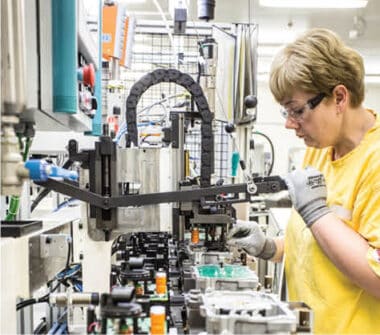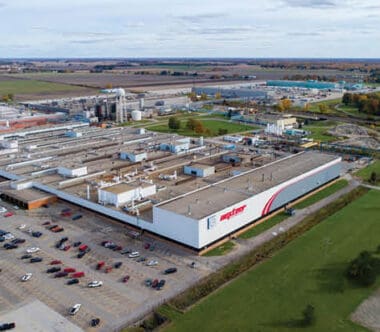Using Predictive Analytics to Improve Product Quality and Performance

Case study in how Nexteer is deploying predictive analytics to improve critical manufacturing processes, optimize production and reduce costs.

TAKEAWAYS:
● Collecting and analyzing data from sensors, machine logs and other sources can identify patterns and anomalies, enabling engineers to take proactive measures that prevent downtime, optimize production and reduce costs
● Predictive analytics can enhance communication and collaboration throughout a manufacturing operation.
● Harnessing the power of data and advanced analytics is key to Industry 4.0-level digital transformation.
Automotive steering and driveline product manufacturer Nexteer wanted to improve its critical manufacturing processes as part of its Industry 4.0 journey. As one step on that journey, the manufacturer turned to predictive analytics technology to improve the functional performance for its motion control systems and reduce the reject rate for end-of-line function testing. This project was selected as a finalist for the 2023 Manufacturing Leadership Award in the Engineering and Production Technology category.
The objective of the project, which kicked off in January 2020, was to develop and implement predictive analytics tools such as Big Data and machine learning technology to identify features that have an influence on end-of-line function testing. This is a complicated task, since a typical assembly can include thousands of features, including component dimensions, assembly parameters, and process parameters. One key aspect of the project was to install IIOT-based real-time vibration and force monitoring on critical components of its manufacturing process, with the goal of moving problem solving from a reactive to a proactive mode.

“By generating insights from data, the company was able to detect anomalies sooner, which led to … improved performance and reduced rejection rates.”
The result: By generating insights from data, the company was able to detect anomalies sooner, which led to earlier detection of machine issues, as well as improved performance and reduced rejection rates.
“As Nexteer advances its pursuit of increased business efficiency, it has recognized the limitations inherent in a reactive approach to problem-solving,” said Kevin Douglas, Executive Director, Global Manufacturing Engineering with Nexteer. “The necessity of transitioning to a proactive strategy is clear. This project shows Nexteer’s commitment towards a fully proactive future using Industry 4.0 transformation.”
Two Cases in Point
Nexteer made use of several technologies to identify the patterns and anomalies that will help engineers identify potential problems or inefficiencies in the production process. Here are two of the projects that used predictive analytics to improve performance and cost-effectiveness:
Project 1: Reduce the reject rates for end-of-line function tests
Solution: Machine learning algorithms were developed to identify factors that contribute to the end-of-line function tests. A machine learning dashboard incorporating a non-linear regression model predicted, with a 95% confidence interval, that modifications in these pivotal factors would substantially reduce the reject rates.
Result: Implementation of these data-driven recommendations led to a significant decrease in the reject rate, showcasing the efficacy of integrating machine learning techniques in optimizing production quality.
Project 2: Detect and diagnose machine problems causing quality issues with component manufacturing
Solution: The company designed a real-time system to monitor vibration and cutting forces during machining operations of critical components. The system was comprised of force and vibration sensors, an industrial computer running specialized software, and a connection to a secure business network for the transfer of vibration and force data to a database. They also developed web-based routines to analyze the vibration and force data, ensuring a comprehensive understanding of the machinery’s performance.
Result: Being able to quickly detect and diagnose machine problems before they resulted in increased reject rates resulted in lower operational costs and also enabled proactive machine maintenance.
Improving Crucial Business Metrics
One of the goals of the project was to improve first-time quality by reducing scrap and rework, as well as increasing productivity in high-growth markets. The superior performance of the product that resulted led to increased customer satisfaction and an increase in market share. Being able to collect and analyze data from IoT sensors and the company’s database, among other sources, provided valuable insights into the production processes and equipment performance, allowing for early detection of equipment failure or inefficiencies. This enabled engineers to take proactive measures to reduce downtime and optimize production.
In addition, having data readily available to plant floor personnel empowered operators, maintenance staff, and other production employees to quickly and effectively resolve problems before they became major issues — and improved collaboration and communication throughout the organization.

“Having data readily available to plant floor personnel empowered operators, maintenance staff, and other production employees to quickly and effectively resolve problems before they became major issues.”
Both the advanced analytics and IIOT technologies developed during the project now are being implemented in other critical manufacturing processes.
Steven Harris, Nexteer Vice President, Global Engineering, said, “In our journey towards Industry 4.0, Nexteer is harnessing the power of predictive analytics and Big Data, fundamentally transforming our manufacturing processes. Our goal was clear: enhance the functional performance of our systems and evolve from reactive to proactive problem-solving. This initiative has not only achieved our initial goals but also catalyzed productivity gains in key growth sectors. This success demonstrates our commitment to innovation and continuous improvement, setting a new standard in the automotive industry. Through this project, we are moving confidently forward, embodying the true spirit of Industry 4.0.” M

COMPANY FACT FILE
Name: Nexteer Automotive
Sector: Automotive
HQ location: Auburn Hills, MI
Revenues: $1 billion to $9.9 billion
Employees: 5,000 plus Employees
Web url: www.nexteer.com

Sue Pelletier is a contributing editor with the Manufacturing Leadership Journal.

Pravin Khurana, Ph.D. is Principal Manufacturing Engineer at Nexteer Automotive. He is responsible for leading IIOT and Advanced Data Analytics projects at Nexteer.